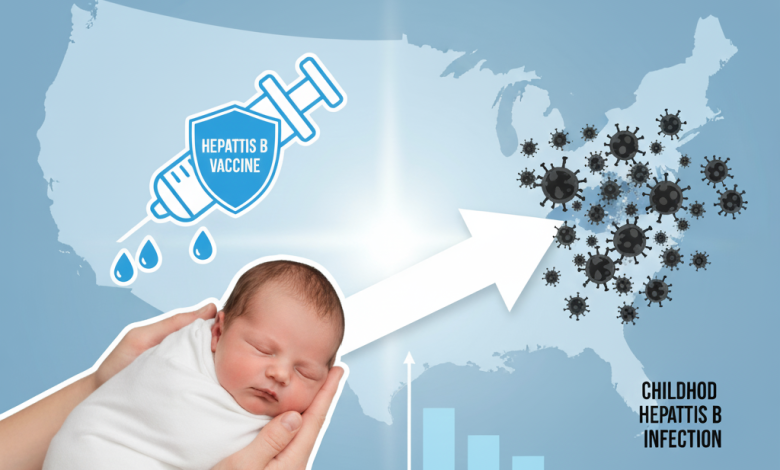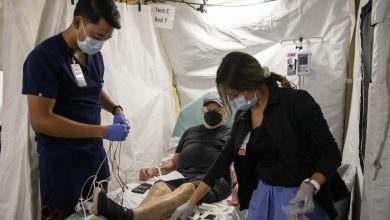How the Hepatitis B Shot for Newborns Nearly Wiped Out Childhood Infections in the U.S.

When one hears of vaccines that changed the course of a disease, the usual candidates are polio, measles, or smallpox. But the hepatitis B (HBV) vaccine, introduced to newborns in the U.S., is among the quieter success stories: a public health intervention that has largely eliminated new infections among children and prevented countless cases of chronic liver disease later in life. Here is the story of how a simple injection given within a day (or two) of birth helped nearly wipe out childhood hepatitis B in America — and why that victory is still fragile.
Background:
Why hepatitis B is dangerous — especially for infants
To understand why the birth-dose vaccine is so powerful, we need to recall hepatitis B’s biology and epidemiology.
Transmission and risk.
Hepatitis B is a virus that infects the liver, transmitted by blood and bodily fluids. In adults, common pathways include sexual contact, needle-sharing (e.g. with injections or drug use), or exposure to blood. But one of the most efficient and dangerous transmission routes is perinatal — from mother to child during childbirth. Microscopic blood contact, or contact with body fluids during the delivery process, can transmit the virus. Additionally, even small exposures (such as open cuts, shared toothbrushes or soiled surfaces, minor bleeding) could transmit HBV, particularly in household or childcare settings.
Infants are especially vulnerable: when infection occurs in the first year of life, the chance that it becomes chronic (long-term, lifelong) is extremely high — roughly 90 % of neonatal or infant infections become chronic, compared to only 5–10 % of adult-acquired infections. Chronic hepatitis B is dangerous: it can lead, over decades, to cirrhosis (scarring of the liver), Acute liver failure, and hepatocellular carcinoma (liver cancer).
Why early childhood infections were important.
Before widespread vaccination, many infections among young children went undetected, later manifesting only as liver disease in adulthood. Moreover, children — especially toddlers or preschoolers with occasional bleeding injuries, oral contacts, or shared hygiene items — could spread HBV in household or daycare settings. Thus, interrupting infant and childhood transmission was essential to halting the virus’s spread.
In U.S. children younger than five, estimates before vaccination suggested prevalence rates of chronic HBV of several parts per thousand, though regional and risk-group variation was large.
Immediate impacts: Declines in infections among children
The results were dramatic and relatively quick.
Reductions in HBV cases among children.
Within a decade of the universal birth-dose policy, reported hepatitis B cases among U.S. children aged 6–19 dropped by about 68 %.Because many infections were asymptomatic in childhood, surveillance on reported “acute” cases underestimates the true drop — but the trend is clear: new transmissions were collapsing.
Among birth cohorts that underwent infant vaccination, later prevalence studies found that adolescents and adults from those cohorts had a 76 % lower prevalence of HBV infection compared to pre-vaccine generations. In other words, not only were acute childhood cases virtually disappearing, but chronic carriers were much rarer in vaccinated cohorts.
Near elimination of perinatal transmission.
Because the birth dose interrupts mother-to-child transmission — especially for mothers whose infection was unknown or unscreened — it has nearly eliminated perinatal HBV transmission in the U.S. That means fewer babies are spared from being born with an infection.
Long-term protection and reduced liver disease.
After completing the vaccine series (typically 3 doses by 15 months), about 98 % of healthy infants mount protective immunity, often lasting 30+ years. Modeling and long-term epidemiological data suggest that the vaccination reduces risk of liver cancer by ~84 %, and death from liver disease by ~70 %. Over decades, that translates to thousands of prevented cancers, cirrhosis cases, transplant needs, and deaths.
Combined, these impacts amount to a near-eradication of new childhood HBV infections in the U.S.
Why the birth-dose strategy works so effectively
The success of the newborn HBV vaccine program is not accidental — it rests on several interlocking features.
- Immediate timing (within 24 hours).
Studies show that administering the vaccine (and HBIG when appropriate) as soon as possible after birth offers stronger protection, especially against perinatal transmission. Delaying beyond the first day raises the risk that transmission may already have occurred. - Acts as both prophylaxis and the first dose in the series.
Rather than being an afterthought, the birth dose becomes the first step in a 3-dose (or more, depending on schedule) vaccination series. The infant’s immune priming begins immediately rather than waiting. - Safety net for unrecognized maternal infection.
Because not all pregnant women are screened (or screened correctly), or may become infected late in pregnancy, the universal birth dose ensures that no infant is left unprotected just because maternal status was “negative” or unknown. - Simplicity and standardization.
A universal approach reduces complexity. Every newborn — regardless of risk factors — gets the dose, which simplifies hospital protocols, reduces decision-making errors, and minimizes “missed” infants. - Encouragement of full series compliance.
Evidence suggests that infants who receive the birth dose are more likely to complete the full vaccination series on schedule for HBV and other vaccines. - Long-lasting immunity and herd effects.
Over time, vaccinated cohorts contribute to reduced circulation of HBV in the community. Fewer carriers, fewer sources of spread, less chance for exposure — all feed back into reducing new cases.
Challenges and remaining gaps
While the U.S. has had major success, the story is not entirely one of perfection. Some challenges remain:
Vaccine refusal and delays.
In certain jurisdictions and hospitals, some parents refuse or delay the birth-dose vaccine. A study in Washington, DC (2017–2022) showed that refusal rates declined from ~12.1 % of births in 2017 to ~3.5 % in 2022 — a strong improvement but still a nontrivial rate of missed births.
Efforts to improve timeliness are ongoing. One hospital-based intervention raised the proportion of infants receiving the HBV vaccine within 24 hours from 35.5 % to 78.8 %.
Preterm or low-weight infants.
For premature infants or those under 2,000 grams, especially if born to HBV-positive mothers, the timing and dosing of the birth dose may need modification (delayed or repeated) due to weaker immune responses and safety considerations.
Gaps in prenatal screening or maternal care.
While most pregnant women undergo HBV screening, some are missed (due to lack of prenatal care, late entry, or screening errors). The birth dose remains crucial in those circumstances. But improving prenatal HBV screening and care is still necessary.
Long-term waning or booster needs.
While most vaccinated individuals maintain protection for decades, for a minority the antibody levels fall below detectable thresholds. But data show that memory immune responses remain adequate in most for long-term protection.
Potential policy reversals or debates.
As of 2025, a reconstituted U.S. vaccine advisory panel has raised the question of delaying the first HBV dose in infants of HBV-negative mothers to one month, rather than immediately at birth. Public health experts warn that such a change might reintroduce preventable infections and erode confidence in vaccinations.
The Hepatitis B Foundation has expressed strong opposition to revising the universal birth dose recommendation, citing decades of safety and synthesis of evidence.
Modeling the “nearly wiped out” narrative
It’s fair to ask — how close did the U.S. come to eliminating childhood HBV? The term “nearly wiped out” is not hyperbole; modeling and epidemiological data strongly support it.
- Among children and adolescents, reported acute HBV incidence dropped from ~ 3 per 100,000 (in 1990) to ~ 0.3 per 100,000 by 2002, and today is below 0.1 per 100,000.
- In birth cohorts vaccinated from infancy, prevalence of chronic HBV is drastically lower (e.g. 76 % lower) compared to pre-vaccine cohorts.
- Because perinatal transmission has been virtually eliminated among most births, new childhood-acquired infections are exceedingly rare in the vaccinated population.
So “nearly wiped out” is apt: the virus has not disappeared entirely, but for all practical measures in childhood infection, the burden is now vanishingly small in the U.S.
Moreover, the reduction is consequential: preventing even one chronic HBV infection avoids decades of potential liver damage, cancer risk, healthcare costs, and mortality.
Anecdotes, lessons, and global parallels
The U.S. story offers lessons, and many parallels exist globally.
Hospital-based implementation and protocol change.
In hospitals and maternity centers, clinical workflow changes (standing orders, default vaccine orders, staff education) proved critical to improving timely birth-dose coverage. Some hospitals saw dramatic increases with minimal disruption.
Linking to other immunizations.
The HBV birth dose was also a stepping stone to improving compliance with the entire childhood immunization schedule. Infants who get the first dose early tend to stay on schedule for others.
Global adoption and challenges.
In many countries, hepatitis B remains a major public health burden. The World Health Organization (WHO) encourages universal newborn HBV vaccination globally. However, in many low- and middle-income countries, coverage of the birth dose remains low (global average ~42 %) due to logistical, financial, staffing, cold-chain, and health system constraints.
Models estimate that scaling newborn HBV vaccination coverage to 90 % globally could prevent millions of chronic infections and over a million HBV-related deaths by 2030.
In highly endemic countries (e.g. parts of Asia, Africa), newborn immunization programs have reduced HBV prevalence among children under five from ~5 % or more to <1 %.
Thus, the U.S. success is not unique, but among the strongest examples of how birth-dose vaccination can transform disease burden in a generation.
Policy, controversy, and defending the gains
Given how successful the HBV birth dose program has been, one might assume it’s beyond critique. But vaccine policy must continually adapt — and in 2025, the U.S. faces renewed debate.
Revisiting timing.
As noted, a vaccine advisory panel has considered delaying the first HBV dose to one month for infants born to mothers who test negative, rather than giving it immediately after birth. Critics warn that this would re-open windows of vulnerability, especially for infants whose mothers’ status is misclassified or not monitored.
Risks of policy rollback.
Public health experts caution that reversing or weakening the birth-dose recommendation could lead to:
- Increased perinatal transmission
- More administrative complexity and errors
- Lower compliance or confusion among providers
- Disproportionate harm to underserved populations (e.g. infants of mothers with poor prenatal care)
- Loss of public trust in vaccine consistency
The Hepatitis B Foundation, among others, has publicly objected to revisiting the policy, emphasizing decades of evidence for safety and effectiveness.
Vaccine hesitancy and misinformation.
Like all vaccines, HBV vaccination must contend with hesitancy, misinformation, and refusal. The DC example of refusal rates dropping from ~12+ % to ~3.5 % over five years shows progress, but vigilance is necessary. Spatial clustering of vaccine refusal nationally also poses risks to remaining pockets of vulnerability.
Monitoring and surveillance.
To maintain success, continual surveillance of HBV infection, vaccine safety, breakthrough cases, and coverage is essential. Policymakers must ensure that any changes are evidence-based, transparent, and responsive.
conclusion:
The story of the hepatitis B shot for newborns in the U.S. is among the less heralded triumphs of modern medicine. By shifting to universal birth-dose vaccination, the U.S. effectively halted perinatal HBV transmission, drove childhood HBV infections to near extinction, and reduced chronic HBV prevalence in vaccinated generations. The consequences are lives saved, cancers prevented, and suffering averted.
Yet this victory is not permanent by default. It rests on sustained high vaccine coverage, public trust, sound policy, and vigilance. Reopening debates about delaying the first dose or relaxing standards may invite back preventable infections. In a medical world that sometimes celebrates novelty, it is worth pausing to appreciate that, sometimes, the greatest breakthroughs are in steadfast implementation of proven tools.




